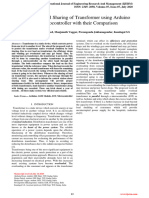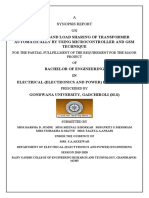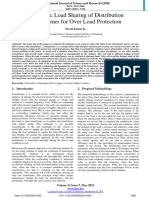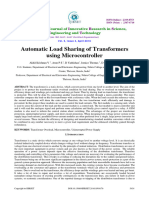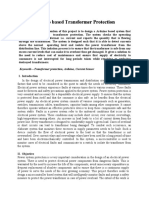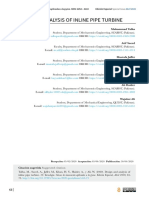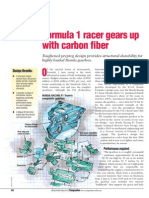International Research Journal of Engineering and Technology (IRJET) e-ISSN: 2395-0056
Volume: 06 Issue: 04 | Apr 2019 www.irjet.net p-ISSN: 2395-0072
Load sharing of Transformer using Microcontroller
K V Shashankkumar1, Raghavendra Naik2, Naresh Nayak3, Prof.Altaf Mudhol4
1,2,3,Anjuman Institute of Technology and Management (AITM), Bhatkal
4professor,Department of Electrical and Electronics engineering (AITM),Bhatkal
---------------------------------------------------------------------***---------------------------------------------------------------------
Abstract - The transformer is a static device, which converts Transformers being one of the most significant equipment in
power from one level to another level. The aim of the project is the electric power system, needs protection as a part of the
to protect the transformer under overload condition by load general system protection approach. Moreover the
sharing. Due to overload on transformer, the efficiency drops increasing population and their unavoidable demands have
and windings get overheated and may get burnt. Thus by lead to an increasing demand on electrical power. With this
sharing load on transformer, the transformer is protected. increased needs, the existing systems have become
This will be done by connecting another transformer in overloaded. The overloading at the consumer end appears at
parallel through a micro-controller. The microcontroller the transformer terminals which can affect its efficiency and
compares the load on the first transformer with a reference protection systems. Due to overload on the transformer, the
value. When the load exceeds the reference value, the second efficiency drops and the windings gets over heated and may
transformer will share the extra load. Therefore, the two get burnt. It takes a lot of time to repair and involves a lot of
transformer work efficiently and damage is prevented. In this expenditure. Transformers are occasionally loaded beyond
project three modules are used to control the load currents. nameplate ratings because of existing possible contingencies
The first module is a sensing unit, which is used to sense the on the transmission lines, any failure or fault in power
current of the load and the second module is a control unit. systems, or economic considerations. One of the reported
The last module is microcontroller unit and it will read the damage or tripping of the distribution transformer is due to
analogue signal and perform some calculation and finally thermal overload. To eliminate the damaging of
gives control signal to a relay. The advantages of the project transformers due to overloading from consumer end, it
are transformer protection, uninterrupted power supply, and involves the control against over current tripping of
short circuit protection. When designing low-voltage power distribution transformer. Rise in operating temperature of
system to the supply large load currents, paralleled lower- the transformer due to overloading has an influence on
current modules are often preferred over a single, large power ageing of transformers. The accelerated aging is one of the
converter for several reasons. These include the efficiency of main consequences of overloading power transformers.
designing and manufacturing standard modular converters Thus load limitations must be implemented to operate the
which can be combined in any number necessary to meet a transformers within safe limits. Moreover on overloading the
given load requirement and the enhanced reliability gained transformers voltage regulation may increase and power
through redundancy. factor drops.
The project is all about protecting the transformer under
KEYWORDS: Capacity, Interruption, Load; System, overload condition. This can be done by connecting another
Transformer, Microcontroller. transformer in parallel through a microcontroller and a relay
which shares the excess load of the first transformer. The
1.INTRODUCTION transformers are switched alternatively to avoid thermal
overloading. Therefore, two transformers work efficiently
Power travels from the power plant to house through an under overload condition and damage can be prevented. If
amazing system called the power distribution grid. For there is a further increase in load beyond the capacity of two
power to be useful in a home or business, it comes off the transformers there will be a priority based load shedding of
transmission grid and is stepped-down to the distribution consumers which will provide un-interrupted power supply
grid. This may happen in several phases. The place where the for the hospitals, industries etc.
conversion from "transmission" to" distribution" occurs is in
a power substation. It has transformers that step 1.1 Objectives
transmission voltages (in the tens or hundreds of thousands
of volts range) down to distribution voltages (typically less The main aim of the project is to protect the
than 10,000 volts). It has a “bus” that can split the transformer under overload condition by sharing load with a
distribution power off in multiple directions. It often has standby transformer and to provide un-interrupted power
circuit breakers and switches so that the substation can be supply to the consumers.
disconnected from the transmission grid or separate
distribution lines can be disconnected from the substation
when necessary.5 8
© 2019, IRJET | Impact Factor value: 7.211 | ISO 9001:2008 Certified Journal | Page 3831
� International Research Journal of Engineering and Technology (IRJET) e-ISSN: 2395-0056
Volume: 06 Issue: 04 | Apr 2019 www.irjet.net p-ISSN: 2395-0072
2. LITERATURE REVIEW parallel can also be increased according to demand of a
particular area.
Rekha.T,BinduPrakash,Asna.S,Dinesh.Sand
Nandana. S.Prasad (2015), Distribution transformers are 3. METHODOLOGY
an important part of power system which distributes power
to the low-voltage users directly, and its operation condition
is important for the entire distribution network operation.
However, their life is significantly reduced if they are
subjected to overloading and over temperature resulting in
unexpected failures and loss of supply to a large number of
customers thus effecting system reliability. Protection
against fault in power systems is very essential and vital for
its reliable performance. This project is a simplified
approach to protect the transformers from unusual
conditions. For this purpose two similar types of distribution
transformers are used so that, if any one transformer fails,
then immediately another transformer is brought into the
circuit during over loading, over temperatures, input voltage
variations and provides conventional 230V supply to the
fig-1:Block diagram
consumers without burning of transformers. Most of the
loads (e.g. Induction motors, arc lamps) are inductive in In the block diagram circuit breakers are used to
nature and hence have low lagging power factor. The low make and break the connections to the transformers. A relay
power factor is highly undesirable as it causes an increase in is used to send a tripping signal to the circuit breakers and
current, resulting in additional losses of active power in all they are energized on receiving a signal from the
the elements of power system from power station generator microcontroller. The current transformer is used for
down to the utilization devices. So in this paper an automatic measurement purpose.
power factor correction circuit is also incorporated with the Three identical transformers are using which are
load sharing module. connected in parallel through change over relay.
Transformer-TF1 is a main transformer, which is called
Ashish R. Ambalkar, Nitesh M. Bhoyar, Vivek V. master transformer and transformer-TF2 is an auxiliary
Badarkhe and Vivek B. Bathe (2015), The transformer is transformers which is called as slave transformers. Each
very costly and bulky equipment of power system. It transformer has its own load handling capacity. In case of a
operates for 24 hours of a day and feeds the load. Sometimes normal operation the master transformer shares the load
the situation may occur when the load on the transformer is but as the load is beyond the rated capacity of main
suddenly increased above its rated capacity. When this transformer the slave transformer is connected in parallel
situation occurs, the transformer will be overloaded and automatically and shares the load.
overheated and damage the insulation of transformer
resulting in interruption of supply. The best solution to avoid Load switching network is provided to ON/OFF the
the overloading is to operate the number of transformers in load on the transformers which is connected to load bank.
parallel. In this work, a slave transformer shares the load of Shunt is used to distribute the current to all the sections of
master transformer in the case of over load and over the circuit. Comparator is having two inputs one is from
temperature. A sensor circuit is designed to log the data from shunt and the second is from the reference voltage.
master transformer and if it is found to be in overload Reference voltage is set by the user. Comparator
condition, immediately the slave transformer will be (microcontroller) compares the reference voltage and
connected in the parallel to the master transformer and the system voltage continuously and the output signal is given
load is shared. Initially when we switched ON the load that to the relay driver circuit. Relay driver circuit consists of
load will be shared by the first transformer. Once load has NPN transistor to drive the relay. Relay driver gives the
been increased on first transformer above its rated capacity signal to the change over relay in case of overload
then the stand by transformer (second) will share the load conditions. Change over relay closes its contact when load
automatically. . In this work we are used a relay and on the master transformer is more than it’s rated capacity
comparator IC’s for automatic load sharing between three and the transformer-T2 i.e. slave transformer is
transformers. The number of transformers to be operated in automatically connected in parallel with the main
transformer and if the load is increased to such a amount
© 2019, IRJET | Impact Factor value: 7.211 | ISO 9001:2008 Certified Journal | Page 3832
� International Research Journal of Engineering and Technology (IRJET) e-ISSN: 2395-0056
Volume: 06 Issue: 04 | Apr 2019 www.irjet.net p-ISSN: 2395-0072
that can’t be handled with the two transformers then the 4.RESULTS
third transformer T3 is automatically connected in parallel
with T1 & T2 and shares the load. Due to which the
transformer-T1 is not overloaded and the problem like
overheating, burning of winding of transformer and un-
interruption of supply is gets eliminated by this
arrangement. The visual indicator contains the LED‟s which
shows the ON/OFF status of the all transformers.
3.1 Circuit diagram
Fig -3:load shared by single transformer
Fig-2:Circuit diagram of system
3.1 Materials used
The following materials are used for load sharing of
transformer
Table -1: components
Fig -4:load shared by both transformer
RATING
SL NO. COMPONENTS
USED 4.1 Advantages
1 TRANSFORMER 1 KVA
1) Automatic load sharing by transformers.
RELAY 5V/10A 2) No manual errors are taking place.
2
3) It prevents the main transformer from damage due to
the like overload and overheats.
CURRENT SENSOR ACS712/5A
3 4) Un-interrupted power supply to the consumers is
supplied.
ARDIUNO UNO ATMEGA 5) Complete monitoring of transformers.
4
328P
3. CONCLUSIONS
LAMP LOAD VARIABLE
5
In this project we observed that if load on one
transformer is increases then the relay will sense the change
in current & microcontroller operates & slave transformers
comes automatically in operation to share the load.
The work on “Automatic load sharing of
transformers” is successfully designed, tested and a demo
unit is fabricated
for operating three transformers in parallel to share the load
automatically with the help of change over relay and
© 2019, IRJET | Impact Factor value: 7.211 | ISO 9001:2008 Certified Journal | Page 3833
� International Research Journal of Engineering and Technology (IRJET) e-ISSN: 2395-0056
Volume: 06 Issue: 04 | Apr 2019 www.irjet.net p-ISSN: 2395-0072
relay driver circuit and also to protect the transformers [5]. Hassan Abniki, H.Afsharirad, A.Mohseni, F.
from overloading and thus providing an uninterrupted Khoshkhati, Has-san Monsef, PouryaSahmsi
power „Effective On-line Parameters for Transformer
supply to the customers. Monitoring and Protection‟, on Northern American
Power Symposium (NAPS), pp 1-5, September 2010.
ACKNOWLEDGEMENT
[6]. Tong Xiaoyang, Wu Guanging, Zhang Guangehun,
We consider it as a privilege to articulate a few words of Tan Yong-dong „A Transformer Online Monitoring
gratitude and respect to all those deserving individuals who and Diagnosis Em-bedded System Based on TCP/IP
guided us in this project. First and foremost, we would like to and Pub/Sub New Technology‟, on Properties and
extend our profound gratitude and our sincere thanks to our Applications of Dielectric Materials, vol 1, pp 467-
guide Altaf M. professor, Department of Electrical and 470, June2003.
Electronis Engineering, Anjuman Institute of Technology and
Management (AITM), Bhatkal, who constantly supported and [7]. Saied M.M., Fetih Nabil H,El-Shewy, Hamed M.,
encouraged us during every step of dissertation. We really "Optimal Expansion of Transformer Substations, "
feel highly indebted to him for constantly guiding us to Power Engineering Review, IEEE , vol.-2, pp.30, Nov.
continue our work and giving us short term goals. 1982.
We are thankful to our project coordinator, Iqbal Ahmed,
Professor, Department of Electrical and Electronics [8]. S.V.kulkarni & S.A Khaparde, Transformer Energy
Engineering, AITM, Bhatkal for his immense support Design And Practical, Crc Press 2004, Edition -2004,
throughout this project. PP-32-33.
We take this opportunity to thank Dr.M.A. Bhavikatti,
Principal, AITM, Bhatkal for his encouragement and useful
suggestions to pursue this work.
REFERENCES
[1]. Dr.J.B.V. Subrahmanyam, T.C. Subramanyam,
T.C.Srinivasarao,M.Kalavani and HarithaInavolu,
“Auto Control of a Standby Transformer Using
Microcontroller”, International Journal of Advances
In Engineering Research, Vol. 2, Issue 5, pp. 1199-
1204, 2011.
[2]. S.R.Balan, P.Sivanesan, R.Ramprakash,
B.Ananthakannan and K.MithinSubash,“ GSM Based
Automatic Substation LoadShedding and Sharing
Using Programmable Switching Control”, Journal of
Selected Areas in Microelectronics, Volume 6, Issue
2, pp. 59-61, 2014.
[3]. Ashish R. Ambalkar, Nitesh M. Bhoyar, Vivek V.
Badarkhe and Vivek B. Bathe, “Automatic Load
Sharing of Transformers”, International Journal for
Scientific Research & Development, Volume 2, Issue
12, pp. 739-741,2015.
[4]. Rekha.T,BinduPrakash, Asna. S, Dinesh.S and
Nandana.S.Prasad, “An Intelligent Method for Load
Sharing of Transformers With Temperature
Monitoring and Automatic Correction of Power
Factor”, International Journal Of Engineering
Sciences & Research Technology, Volume 4,
Issue3, pp. 416-421, 2015.
© 2019, IRJET | Impact Factor value: 7.211 | ISO 9001:2008 Certified Journal | Page 3834



